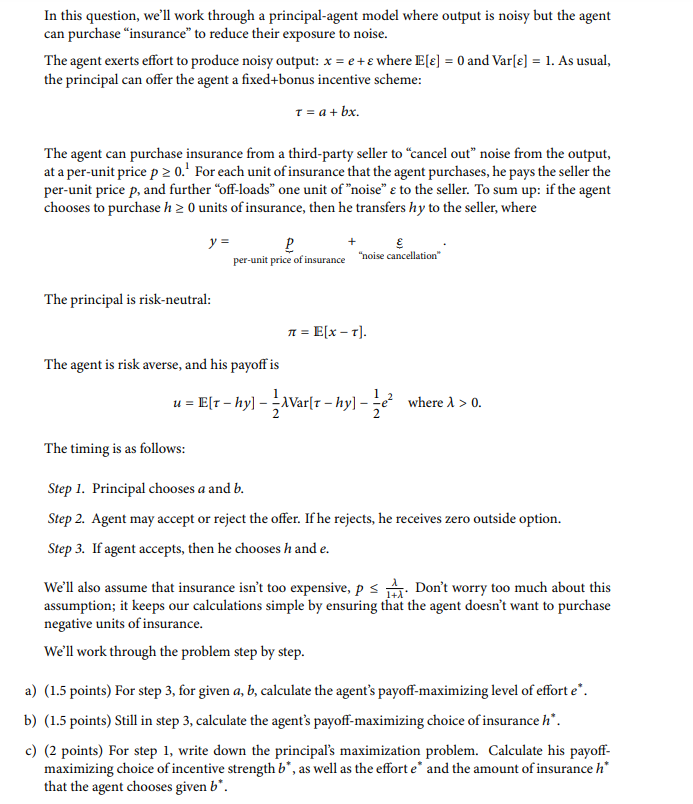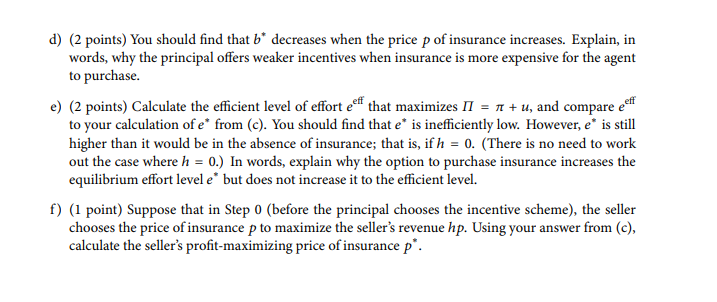

In this question, we'll work through a principal-agent model where output is noisy but the agent can purchase "insurance" to reduce their exposure to noise. The agent exerts effort to produce noisy output: x=e+ where E[]=0 and Var[]=1. As usual, the principal can offer the agent a fixed+bonus incentive scheme: =a+bx. The agent can purchase insurance from a third-party seller to "cancel out" noise from the output, at a per-unit price p0.1 For each unit of insurance that the agent purchases, he pays the seller the per-unit price p, and further "off-loads" one unit of "noise" to the seller. To sum up: if the agent chooses to purchase h0 units of insurance, then he transfers hy to the seller, where y=per-unitpriceofinsurancep+"noisecancellation". The principal is risk-neutral: =E[x]. The agent is risk averse, and his payoff is u=E[hy]21Var[hy]21e2where>0. The timing is as follows: Step 1. Principal chooses a and b. Step 2. Agent may accept or reject the offer. If he rejects, he receives zero outside option. Step 3. If agent accepts, then he chooses h and e. We'll also assume that insurance isn't too expensive, p1+. Don't worry too much about this assumption; it keeps our calculations simple by ensuring that the agent doesn't want to purchase negative units of insurance. We'll work through the problem step by step. a) (1.5 points) For step 3, for given a,b, calculate the agent's payoff-maximizing level of effort e. b) (1.5 points) Still in step 3, calculate the agent's payoff-maximizing choice of insurance h. c) (2 points) For step 1, write down the principal's maximization problem. Calculate his payoffmaximizing choice of incentive strength b, as well as the effort e and the amount of insurance h that the agent chooses given b. d) ( 2 points) You should find that b decreases when the price p of insurance increases. Explain, in words, why the principal offers weaker incentives when insurance is more expensive for the agent to purchase. e) (2 points) Calculate the efficient level of effort eeff that maximizes =+u, and compare eeff to your calculation of e from (c). You should find that e is inefficiently low. However, e is still higher than it would be in the absence of insurance; that is, if h=0. (There is no need to work out the case where h=0.) In words, explain why the option to purchase insurance increases the equilibrium effort level e but does not increase it to the efficient level. f) ( 1 point) Suppose that in Step 0 (before the principal chooses the incentive scheme), the seller chooses the price of insurance p to maximize the seller's revenue hp. Using your answer from (c), calculate the seller's profit-maximizing price of insurance p. In this question, we'll work through a principal-agent model where output is noisy but the agent can purchase "insurance" to reduce their exposure to noise. The agent exerts effort to produce noisy output: x=e+ where E[]=0 and Var[]=1. As usual, the principal can offer the agent a fixed+bonus incentive scheme: =a+bx. The agent can purchase insurance from a third-party seller to "cancel out" noise from the output, at a per-unit price p0.1 For each unit of insurance that the agent purchases, he pays the seller the per-unit price p, and further "off-loads" one unit of "noise" to the seller. To sum up: if the agent chooses to purchase h0 units of insurance, then he transfers hy to the seller, where y=per-unitpriceofinsurancep+"noisecancellation". The principal is risk-neutral: =E[x]. The agent is risk averse, and his payoff is u=E[hy]21Var[hy]21e2where>0. The timing is as follows: Step 1. Principal chooses a and b. Step 2. Agent may accept or reject the offer. If he rejects, he receives zero outside option. Step 3. If agent accepts, then he chooses h and e. We'll also assume that insurance isn't too expensive, p1+. Don't worry too much about this assumption; it keeps our calculations simple by ensuring that the agent doesn't want to purchase negative units of insurance. We'll work through the problem step by step. a) (1.5 points) For step 3, for given a,b, calculate the agent's payoff-maximizing level of effort e. b) (1.5 points) Still in step 3, calculate the agent's payoff-maximizing choice of insurance h. c) (2 points) For step 1, write down the principal's maximization problem. Calculate his payoffmaximizing choice of incentive strength b, as well as the effort e and the amount of insurance h that the agent chooses given b. d) ( 2 points) You should find that b decreases when the price p of insurance increases. Explain, in words, why the principal offers weaker incentives when insurance is more expensive for the agent to purchase. e) (2 points) Calculate the efficient level of effort eeff that maximizes =+u, and compare eeff to your calculation of e from (c). You should find that e is inefficiently low. However, e is still higher than it would be in the absence of insurance; that is, if h=0. (There is no need to work out the case where h=0.) In words, explain why the option to purchase insurance increases the equilibrium effort level e but does not increase it to the efficient level. f) ( 1 point) Suppose that in Step 0 (before the principal chooses the incentive scheme), the seller chooses the price of insurance p to maximize the seller's revenue hp. Using your answer from (c), calculate the seller's profit-maximizing price of insurance p








